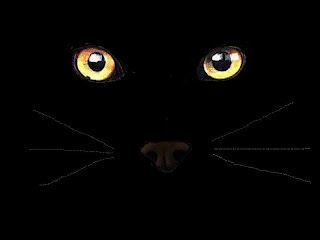Answer by ANDREA SEABROOK: Eyes that glow in the pitch-black night make for many a scary tale. But why do some animals' eyes glow at night?
"A lot of the animals we see, especially the ones that go out at night, have a special, reflective surface right behind their retinas," says Dr. Cynthia Powell, a veterinary ophthalmologist at Colorado State University. That light-reflecting surface, called the tapetum lucidum, helps animals see better in the dark.
When light enters the eye, it's supposed to hit a photoreceptor that transmits the information to the brain, Powell explains. But sometimes the light doesn't hit the photoreceptor, so the tapetum lucidum acts as a mirror to bounce it back for a second chance.
A large number of animals have the tapetum lucidum, including deer, dogs, cats, cattle, horses and ferrets. Humans don't, and neither do some other primates. Squirrels, kangaroos and pigs don't have the tapeta, either.
And not all eyes animals' glow the same color. Powell says this is due to different substances — like riboflavin or zinc — in an animal's tapetum. "Also," she says, "there are varying amounts of pigment within the retina, and that can affect the color." Age and other factors also can change the color, so even two dogs of the same species could have eyes that glow different colors.
Cats often have eyes that glow bright green, though Siamese cats' eyes often glow bright yellow. Cat tapeta also tend to reflect a little bit more than dogs, Powell says.
"One of my favorites are miniature schnauzers," she says, which have eyes that tend to glow turquoise. "It's really beautiful."
 Source:http://www.npr.org/
Source:http://www.npr.org/ Answer by Orlin Sorensen :
If you've ever wondered why your cat's eyes seem to glow in the dark, or pondered how a hummingbird finds its way to certain nectar-filled flowers, what you are really asking is, do animals see the way we do? Though we might like to think that animals see the world with the same colors and shadows as human beings-although maybe from a different angle, perhaps high in the sky like an eagle, or under the sea like a shark-the truth is that animal vision is not like our own and differs greatly among animal species.
Glow in the Dark
Human beings are not like tigers, or housecats for that matter, whose eyes are superbly well adapted to seeing in the dark. One reason is that cats have more rods than cones in their retinas, unlike humans, making kitty's night and motion vision superior. (Rods are the receptors that the eye uses for nighttime viewing and sudden movement; cones are used during the daytime and process color information.)
Also, cats' pupils are shaped differently than those of humans (they are elliptical rather than round), which allows for a much larger pupil size. In fact, the most notable feature of nocturnal animals is the size of their eyes. The reason for this is that large eyes can collect more ambient light.
Fun fact: An owl's eyes fill over half of its skull!
As well, cats' eyes open and close much faster than do ours. And cats have a special membrane on the back of their eyes (called the tapetum lucidum, literally meaning "bright carpet") that increases the quantity of light caught by the retina. The tapetum collects and re-emits light back to the retina, giving the rods a second chance to absorb the image, thus maximizing their sensitivity to low light levels. As this light is reflected off the tapetum, the animal's eyes appear to glow.
And You Thought "Four-Eyes" Was Insulting
How about "hundred eyes"? That's the insult you'd have to hurl at a scallop. The scallop's mantle is lined with small blue eyes. Each eye has a lens and a retina which is attached to a branch of the optic nerve. Behind the retina is a tapetum, perhaps the only thing a cat and a sea creature have in common! The hundred or so eyes work together to alert the mollusk to changes in light and motion.
One Step Beyond
When it comes to light, we humans are limited. The light we see with our eyes is really a very small portion of the electromagnetic spectrum.
Bees and butterflies may be small, but they can see better than us. In fact, their range of vision extends into the ultraviolet part of the spectrum, which is invisible to us with the naked eye. The leaves of the flowers they pollinate have special ultraviolet patterns which guide the insects deep into the flower to locate the plant's nectar. So, next time you admire a pretty flower, just think about all the beauty you're not seeing!
Some snakes have an extra pair of "eyes," or sensory organs, located on their foreheads that can detect infrared radiation. They can "see" the heat of a mouse from a meter away, even in conditions where our eyes would detect only pitch black.
Even those common urban pests, pigeons, have one up on us: Pigeons can see patterns of polarized light in the daytime sky which are invisible to us, providing yet another clue to the remarkable homing abilities of these birds.
 Don't Judge a Creature by Its Cones
Don't Judge a Creature by Its ConesWe couldn't forget to tell you about shark vision. Sharks do not possess the same variety of photoreceptors as humans. They have few retinal cones, and as a result, for years it was thought that their vision was much less acute than ours. However, though different from our eyes, shark eyes work just as well, relying on visual pigments such as rhodopsin to supply the color vision we achieve with cones.
Of course, sharks have other advantages as well: They have a sharp sense of hearing and can hear prey many miles away. They also possess a superior sense of smell and can smell even the smallest drop of blood over long distances. Once they are close to their prey, they employ special sensory pores on their heads to detect electrical fields created by prey. Getting scared yet?
Before you go out and rent Jaws, know that you are much more likely to get hit by lightning than eaten by a shark. And here's another cool shark fact: Like cats and scallops, sharks, too, have a tapetum, which gives them about 10 times the light sensitivity we have. This works well in the dark, but the light-enhancing mechanism can be a bother during daylight. So sharks have evolved a fun solution: Many species of sharks have migratory pigment cells that can close up the tapetum under bright-light conditions-basically, a pair of built-in shades!
Source:http://chetday.com/




.jpg)
.jpg)





0 comments:
What do you think?